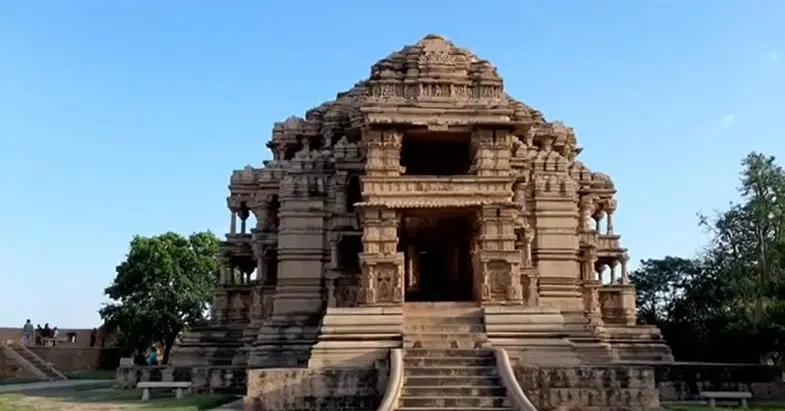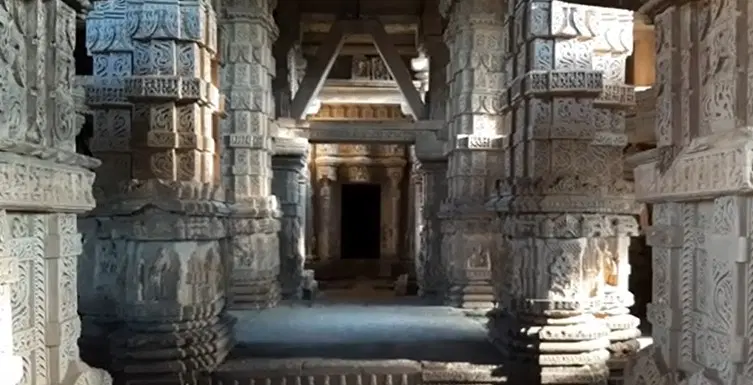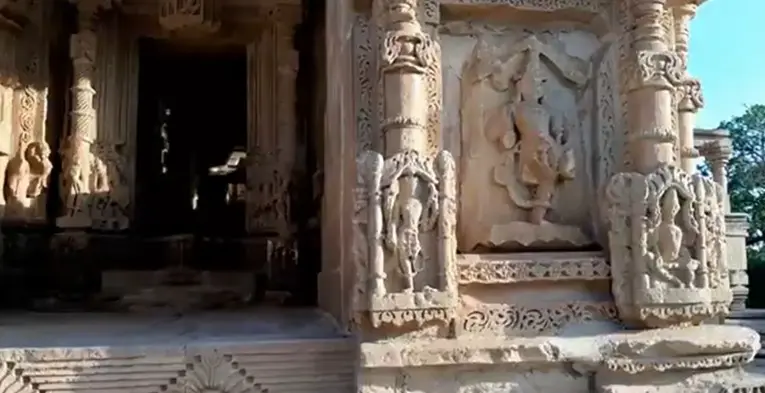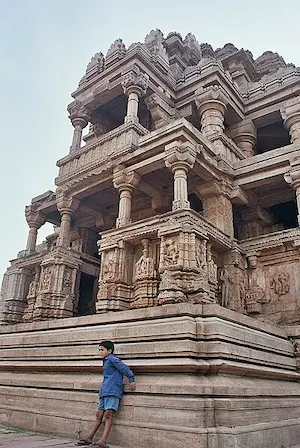The Sas Bahu Temple in Gwalior, called as Sas-Bahu Mandir or Sahastrabahu Temple, is a great 11th-century building made for Lord Vishnu. It is found within the Gwalior Fort area in Madhya Pradesh, India this twin temple shows detailed carvings and a rich past story that draws visitors from all over the world.
Even with its tricky name, the Sas Bahu Temple still attracts history fans, art lovers, and visitors with its lovely art and culture meaning.

Historical Background
The Sas Bahu Temple, made in 1093 AD, was built when King Mahipala ruled the Kachchhapaghata clan. The temple sits inside the Gwalior Fort, which is on a big ͏stone hill and gives wide views of all Gwalior city.
The place of worship, mainly for Lord Vishnu shows the great building style of its time; it has lived through many big changes in history.
The temple’s name comes from the Hindi words Sas (mother-in-law) and Bahu (daughter in-law), showing the bond between the two buildings inside the area. The big temple, for Vishnu, is thought to be built for king’s queen, while small temple, for Shiva, was made for his daughter-in-law, showing family links and love common in old Indian culture.
The temple area first had name Sahastrabahu, which means “One with a Thousand Arms,” pointing to Lord Vishnu. Through the years, the temple has faced big harm from attacks and time, the Bahu temple is mostly in ruins, but the Sas temple still keeps its beauty and fine carvings. Its nice design and detailed carvings show its important past.
Architectural Splendor of Sas Bahu Temple
The Sas Bahu Temple, called the Sahastrabahu Temple too, is a great example of 11th-century Hindu building ͏found in Gwalior, Madhya Pradesh. This temple group has two main parts: the bigger North Temple for Lord Vishnu and the smaller South Temple for Lord Shiva. The design features of Sas Bahu Temple show the art skill of that time with detailed carvings; fancy fronts and a one-of-a-kind layout.
Unique Architectural Features
Bhumija Style: The temple is primarily built in the Bhumija style, characterized by a well-proportioned superstructure and intricately arranged subordinate sikharas (spires). The larger temple features a three-storey mandapa with a cruciform base.
Fancy Carvings: The temple’s outside has nice figures of gods, made-up animals, and pictures from Hindu stories like the Ramayana and Mahabharata. The skill is clear in the fine details on the walls, posts, and roofs.
Many Doors: The temple area has three big doors, letting worshippers reach the mandapa from various ways which is a usual trait in lots of old temples.
Garuda and God Carvings: The doorway is decorated with carvings of Garuda, with images of Br͏ahma, Vishnu and Shiva. This shows the temple’s support for Lord Vishnu.
Lattice Work: The temple features intricate stone filigree work, allowing light to filter through and creating beautiful patterns within the temple.

Current Status of Sas Bahu Temple
Sadley, the Sas-Bahu Temple has taken a lot of harm over the years from many things, like bad weather, attacks, and lack of care. While the big Sas temple still keeps its beauty; the little Bahu temple is in ruins.
Despite the damage, the remaining structure continues to mesmerize visitors with its intricate carvings and architectural brilliance. Conservation efforts are underway to preserve this historical gem for future generations.
As of now, the Sas Bahu Temple remains a significant historical and architectural landmark within the Gwalior Fort complex. Despite facing damage over the centuries due to invasions and neglect, restoration efforts have preserved much of its original architectural style. The temple is actively maintained, and it continues to attract visitors and devotees alike.

Visiting the Sas Bahu Temple in Gwalior: A Complete Travel Guide
The Sas Bahu Temple, a significant historical and architectural site located in Gwalior, Madhya Pradesh, offers visitors a glimpse into India’s rich cultural past. This guide provides detailed information on how to visit the temple, including travel modes, timings, entry fees, and nearby attractions.
Modes of Travel
Gwalior is well-connected by road, rail, and air, making it accessible from major cities across India:
By Air: Gwalior has its own airport, Gwalior Airport, which is connected to major cities like Delhi, Mumbai, and Kolkata. From the airport, you can hire a taxi to reach the temple.
By Train: Gwalior railway station is a major stop for numerous trains across India. The temple is just a short drive from the station.
By Road: Gwalior is connected via state and national highways. Buses, taxis, and private cars can easily reach the city.
Opening Time
The Sas Bahu Temple, being a part of the Gwalior Fort, follows the fort’s timings. It’s advisable to check the latest timings before your visit.
Entry Fee
There is an entry fee to enter the Gwalior Fort, which includes access to the Sas Bahu Temple.

Best Time to Visit
The ideal time to visit the Sas Bahu Temple is from September to March. During these months, the weather in Gwalior is cooler and more pleasant, making it comfortable to explore the temple and its surroundings.
Accommodation
Gwalior offers a range of accommodation options to suit different budgets and preferences. From luxury hotels to budget stays, visitors can choose based on their requirements. It’s advisable to book in advance, especially during the tourist season, to secure the best rates and availability.
Nearby Attractions
While visiting the Sas Bahu Temple, you can also explore other notable sites within Gwalior:
Gwalior Fort: This historic fort offers stunning views and houses several other ancient structures.
Jai Vilas Palace: Known for its luxurious architecture blending Tuscan and Corinthian styles, it’s a must-visit for architecture enthusiasts.
Teli Ka Mandir: Standing over 100 feet tall, this temple is renowned for its unique architectural style and is one of the most impressive temples in Gwalior.
Mansingh Palace: Another architectural marvel, built between 1486 and 1517, showcasing the rich history of the region.
Gwalior Zoo: A family-friendly destination with a variety of wildlife, located near the fort.
Tansen’s Tomb: The final resting place of the legendary musician Tansen.
Gurudwara Data Banke Bihari: A significant Sikh pilgrimage site.
Tips for Your Visit
* Put on comfy shoes, as you will do much walking.
* Take a water bottle, mainly in the hot months.
* Honor the sacredness of a place and wear suitable clothes
* Get a nearby guide to know more about the past and design of the temple.
By using these hints, you can get the most from your trip to Sas Bahu Temple and see the great past of Gwalior.
- Sankata Devi Mandir: A Haven of Divine Grace in Varanasi
- Jalakandeswarar Temple, Vellore: A Gem Within a Fort
- Namakkal Anjaneyar Temple: From Myths to Marvels
- Vettuvan Koil: An Unfinished Monolithic Marvel
- Sun Temple Mahoba: A angelic Marvel in Bundelkhand
Conclusion
The Sas Bahu Temple in Gwalior is more than a spot of prayer. It shows the skillful design and the full cultural mix of old India.
Going to this temple is a trip back in time, a chance to enjoy the art skill and the deep spirit of old India. Whether your an history fan, an art fan, or just a curious tourist; the Sas Bahu Temple gives you a great experience full of surprise and delight.
If you plan ͏a trip to Gwalior, the Sas Bahu Temple is must-see on your list. Its past and design are important, but it also takes you back to time when art and spirit mixed well.
Join the group of folks who have gone th͏rough its holy halls and felt the charm of the Sas Bahu Temple.